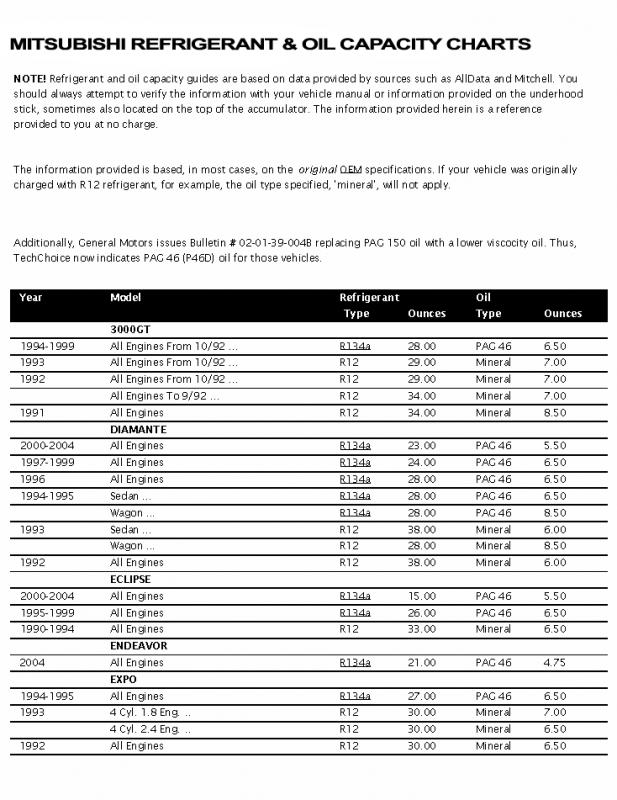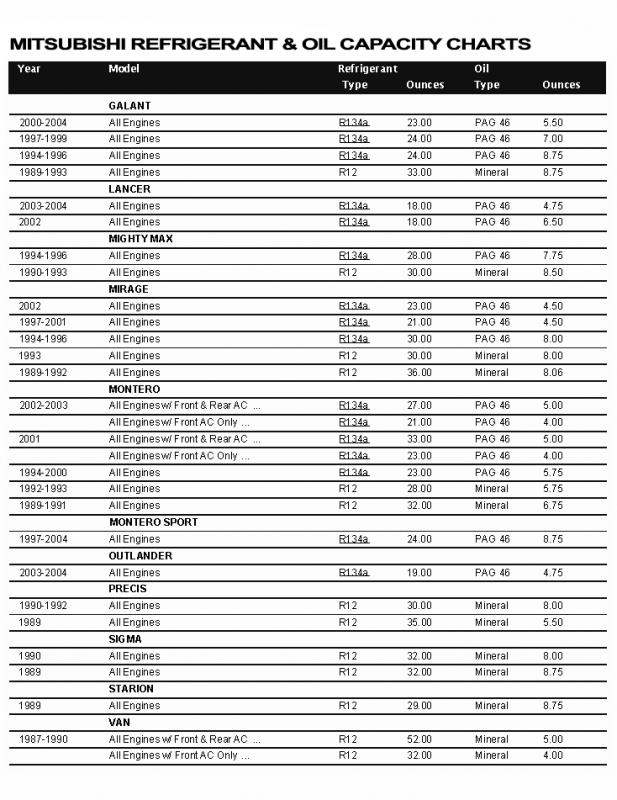MITSUBISHI AC Freon & Oil Specifications & Capacity

 Automotive Air conditioning: how it works
Automotive Air conditioning: how it works
Here, we will discuss the basic function of the main components of your vehicle's A/C system. This information is intended to give the average individual an average understanding of not only what each part is, but also how it functions within the system. Most of the following text is somewhat general.
As always, if you are not confident in your ability to diagnose any Automotive A/C problem, please take your vehicle to a qualified A/C technician.
If you're having a problem with the A/C system there are two ways you can approach solving the problem. The first is to just start replacing components and hope you get lucky by replacing the faulty component the first time. The other method involves doing some actual testing to narrow down the cause of the problem. In order to properly test the A/C system and narrow down the possible causes of your problem, you will have to be able to either diagnose it yourself, or take your vehicle to a qualified, professional A/C technician.
Before we begin with the actual troubleshooting, to properly troubleshoot the A/C system, it's extremely helpful to understand how the automobile A/C cycle works. So, we'll begin by discussing how automotive air conditioning works.
There are two basic types of automotive air conditioning systems. The type of system is determined by the device used to control the expansion of the high pressure, high temperature liquid to a low pressure, low temperature liquid. One system uses an expansion valve while the other uses an orifice tube.
The first component in the A/C cycle is the compressor. The compressor, usually referred to as the "heart" of the A/C system, pumps low temperature refrigerant gas and compresses it into a high pressure, high temperature gas.
The refrigerant is then sent to the condenser which sits in front of the radiator. The condenser removes some of the heat from the refrigerant via the ambient air which passes through its fins, thereby causing the refrigerant to change phase from a hot gas to a warm liquid.
In the expansion valve A/C system, the warm liquid is then passed through a receiver-drier which removes moisture (via a desiccant bag in the drier) from the refrigerant to maximize the efficiency of the heat exchange capability of the refrigerant. No phase change occurs as the refrigerant passes through the receiver-drier.
From there, the refrigerant is then passed through the expansion valve. The expansion valve has a sensing line that is attached to the suction of the A/C compressor. The expansion valve senses the pressure at the suction of the A/C Compressor and modulates to maintain the pressure at the compressor suction.
In the orifice tube system, the warm liquid refrigerant passes directly from the condenser to the orifice tube. The orifice tube is a fixed expansion device. The pressure drop across the orifice tube is proportional to the pressure into the orifice tube. So, the orifice tube system maintains the pressure at the suction of the A/C compressor by cycling the compressor on and off via a clutch. This is the type of system typically used by GM and many Ford vehicles.
The expansion of the warm liquid through the expansion valve or orifice tube causes a pressure drop and hence a temperature drop in the refrigerant. So, out of the expansion device we get a low temperature liquid refrigerant.
The next component in the A/C system is the evaporator. Air from the passenger's compartment passes across one side of the coils in the evaporator. The low temperature liquid refrigerant passes through the other side of the coils. The refrigerant removes heat from the air in the passenger's compartment and returns to the A/C compressor suction as a low temperature gas (phase change).
In the orifice tube system, there is an accumulator located between the evaporator and the A/C compressor suction. The accumulator has moisture removal desiccant just like the receiver-drier used in the expansion valve system. However, it also collects any un-evaporated refrigerant to prevent liquid lock of the compressor. This can occur due to the cycling action of the compressor.
Symptoms, possible causes, and solutions
Below is a table of common problems and possible solutions one will run into while diagnosing an automotive A/C problem. Again, some of this information is generic, and may not always apply in every situation on all vehicles.
Symptom: low compressor discharge pressure
Possible cause/ Repair
Leak in system/ Repair leak in system
Defective expansion valve/ Replace valve
Suction valve closed/ Open valve
Freon shortage/ Add freon
Plugged receiver drier/ Replace drier
Compressor suction valve leaking/ Replace valve
Bad reed valves in compressor/ Replace reed valves
Symptom: high compressor discharge pressure
Possible cause/ Repair
Air in system/ Recharge system
Clogged condenser/ Clean condenser
Discharge valve closed/ Open valve
Overcharged system/ Remove some refrigerant
Insufficient condenser air/ Install large fan
Loose fan belt/ Tighten fan belt
Condenser not centered on fan or too far from radiator/ Center and check distance
Symptom: low suction pressure
Possible cause/ Repair
Refrigerant shortage/ Add refrigerant
Worn compressor piston/ Replace compressor
Compressor head gasket leaking/ Replace head gasket
Kinked or flattened hose/ Replace hose
Compressor suction valve leaking/ Change valve plate
Moisture in system/ Replace drier
Trash in expansion valve or screen/ Replace drier
Symptom: high suction pressure
Possible cause/ Repair
Loose expansion valve/ Tighten valve
Overcharged system/ Remove some refrigerant
Expansion valve stuck open/ Replace expansion valve
Compressor reed valves/ Replace reed valves
Leaking head gasket on compressor/ Replace head gasket
Symptom: compressor not working
Possible cause/ Repair
Broken belt/ Replace belt
Broken clutch wire or no 12v power/ Repair wire or check for power
Broken compressor piston/ Replace compressor
Bad thermostat/ Replace thermostat
Bad clutch coil/ Replace clutch coil
Low Refrigerant - low pressure switch has cut off clutch power/ Add refrigerant
Symptom: evaporator not cooling
Possible cause/ Repair
Frozen coil, switch set too high/ Turn thermostat switch back
Drive belt slipping/ Tighten belt
Hot air leaks into car/ Check for holes or open vents
Plugged receiver drier/ Replace drier
Capillary tube broken/ Replace expansion valve
Shortage of refrigerant/ Add refrigerant
High head pressure/ See high compressor discharge pressure
Low suction pressure/ See low suction pressure
High suction pressure/ See high suction pressure
Defective expansion valve/ Replace expansion valve
Frozen expansion valve/ Evacuate and replace drier
Symptom: frozen evaporator coil
Possible cause/ Repair
Faulty thermostat/ Replace thermostat
Thermostat not set properly/ Set to driving condition
Insufficient evaporator air/ Check for excessive duct hose length, kink or bend
What vent temperatures should you expect from your vehicle?
Table of refrigerant pressures vs. ambient (outside) temperature
Ambient temp Low side pressure High side pressure Center vent temp
60°F 28–38 psi 130–190 psi 44–46°F
70°F 30–40 psi 190–220 psi 44–48°F
80°F 30–40 psi 190–220 psi 43–48°F
90°F 35–40 psi 190–225 psi 44–50°F
100°F 40–50 psi 200–250 psi 52–60°F
110°F 50–60 psi 250–300 psi 68–74°F
120°F 55–65 psi 320–350 psi 70–75°F
Bookmarks